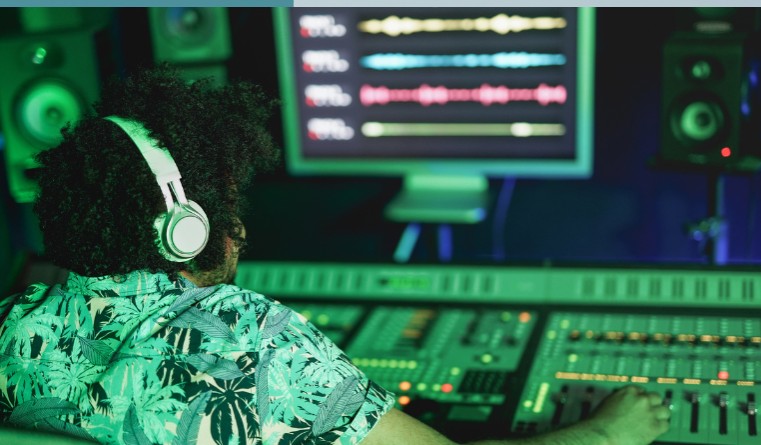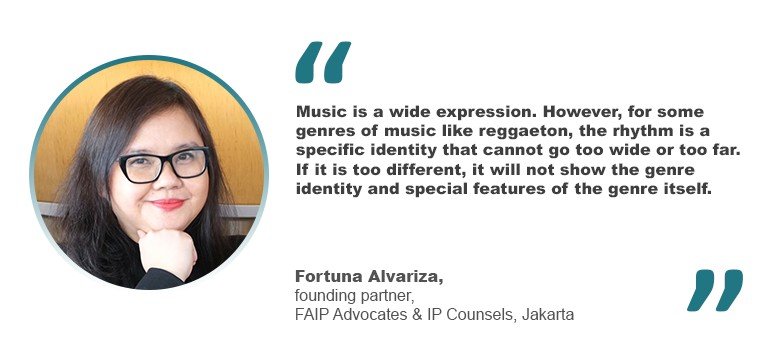Dembow riddim, reggaeton and the copyright lawsuit
31 March 2025

As a recent legal dispute raises questions about copyrightability of rhythms, Excel V. Dyquiangco examines its potential impact on music genres, creativity and how copyright law may shape artistic innovation.
In 1989, Jamaican producer duo Steely & Clevie unknowingly laid the foundation for a global music phenomenon with their song “Fish Market”. This track pioneered the dembow rhythm – the distinctive four-on-the-floor beat that later became synonymous with reggaeton, a music genre that originated in Puerto Rico in the late 1980s and early 1990s and is the dominant sound of Latin pop today.
Now, over three decades later, Steely & Clevie Productions is taking legal action against renowned reggaeton artists El Chombo, Luis Fonsi and Daddy Yankee. They claim these artists unlawfully used the “Fish Market riddim” in their hits, denying Steely & Clevie the recognition and royalties they believe they are rightfully owed. The lawsuit targets 56 songs, including reggaeton anthems like “Despacito” (featuring Justin Bieber) and “Gasolina”, each of which have garnered hundreds of millions, if not billions, of streams. The suit also names a wide range of artists, including Bieber, Stefflon Don and Rauw Alejandro, as well as co-writers, publishing companies and record labels, as defendants.

Interestingly, if this lawsuit becomes successful, it will likely have profound and disruptive consequences on the evolution of not only genres like reggaeton but arguably even hip-hop and pop, where similar beats and rhythms are often sampled and shared, according to Charmayne Ong, a partner at Skrine in Kuala Lumpur.
“If the plaintiffs in the dembow riddim case successfully monopolize the dembow riddim, this would almost certainly dramatically increase the licensing costs for all artists that seek to make any reggaeton and adjacent music. This could affect the whole genre given the prominence in use of the dembow riddim in almost all reggaeton music,” she said.

Her colleague, Gooi Yang Shuh, also a partner at Skrine in Kuala Lumpur, agreed that with increased costs, this would no doubt create significant barriers to musical innovation. “It may in fact cause a complete stagnation of the reggaeton genre as artists would likely be deterred from exploring the space to avoid heavy royalty fees or copyright infringement risks. This will disproportionately impact smaller, independent artists and underground music scenes who lack resources for extensive copyright clearance,” he said.
He continued: “The creative loss would almost certainly have a profound impact given that genres like reggaeton were birthed through a continuously collaborative and reinventive process across generations and geographies. It is reminiscent of the Robin Thicke Blurred Lines case where songwriters and composers widely panned the decision for setting a precedent that common musical elements may be monopolized. Perhaps it will be decided along the lines of the Ed Sheeran case over Marvin Gaye’s ‘Let’s Get It On’, which established that copyright cannot be claimed over commonplace elements of musical composition – in that case, chord progressions rather than rhythms.”

Fortuna Alvariza, a founding partner at FAIP Advocates & IP Counsels in Jakarta, has a similar view that it will take a role in narrowing the evolution of genres like reggaeton. “Music is a wide expression,” she said. “However, for some genres of music like reggaeton, the rhythm is a specific identity that cannot go too wide or too far. If it is too different, it will not show the genre identity and special features of the genre itself. When the rhythm of a specific genre cannot go too wide, and further there are some modifications of the rhythm that has been claimed exclusively as a copyright, the possibility to evolve will be more limited.”
She added: “I am therefore of the opinion that the result of the case will influence the evolution of the reggaeton genre. We all know that a court decision in a jurisdiction is not automatically applied in other jurisdictions. However, the implementation of copyright protection is universally similar in many jurisdictions, and once a decision on a copyright case has been made by a court in one country, it is usually respected by courts in other jurisdictions, although different examinations might still be necessary to be conducted by court of each different jurisdiction.”
Copyrighting a rhythm
With this lawsuit, one question arises. Can you copyright a rhythm? In India, copyright law, as established under the Copyright Act, 1957, provides protection for “musical works” under Section 2(p), which includes compositions of melody and harmony. However, the Act does not specifically address the copyrightability of isolated rhythms or beats. To date, no Indian court has directly ruled on whether a rhythm, such as the dembow riddim, can be independently protected by copyright.
“The principle of originality, as explained in Eastern Book Company v. D.B. Modak, requires a work to possess a ‘modicum of creativity’ to qualify for protection,” said Namrata Pahwa, founder of Chambers of Namrata Pahwa in New Delhi. “This standard suggests that simple, repetitive rhythms, especially those integral to a genre, are unlikely to meet this criterion. Furthermore, Indian copyright law adheres to the idea-expression dichotomy, which protects the expression of an idea but not the idea itself. Rhythms, which are often viewed as fundamental building blocks of music, may be classified as unprotectable ideas, especially if they are essential or commonplace within a particular genre.”
The same is true as that in Malaysia, which specifically addresses whether copyright protection can subsist in a rhythm like the dembow riddim. “Most copyright cases involving musical works concern full musical compositions, as opposed to basic musical or rhythmic patterns. Thus, the ability to claim copyright over a specific rhythm is novel and remains legally ambiguous in Malaysia,” said Ong.
But unlike India and Malaysia, Alvariza said that Indonesian copyright law protects music as a copyright. Therefore, the elements of music such as melody, rhythm, composition and lyrics can be claimed and protected as a copyright.
Legal ownership and cultural significance
With copyright law of some jurisdictions addressing the tension between legal claims of ownership and the cultural significance of rhythms that have become foundational to entire genres, such as reggaeton, this overlap is a critical consideration in the copyright debate. According to Pahwa, rhythms like the dembow riddim are often viewed as cultural elements shared by communities, transcending individual ownership.
“Granting exclusive rights over such rhythms could disrupt the collaborative and iterative nature of music production in genres like reggaeton, hip-hop and traditional Indian folk music,” she said. “Indian courts have historically aimed to strike a balance between creators’ rights and public interest. For instance, in Civic Chandran v. Ammini Amma, the Kerala High Court highlighted the importance of fair dealing to safeguard public access to creative works. Following this reasoning, it is unlikely that Indian courts would support exclusive ownership over rhythms that are integral to musical genres or cultural traditions. This approach aligns with global copyright norms, where common elements essential to a genre (often referred to as scènes à faire) are not eligible for protection.”
Ong added that the basic requirement for sufficient effort to have been expended to make a work original in character, in order for a musical work to be eligible for copyright, in a sense, balances these conflicting tensions.
“This prerequisite recognizes that musical works must have sufficient originality in order to qualify for copyright protection meaning that artists who have created a musical piece which is unprecedently unique and creative can claim copyright ownership over their creation. At the same time, rhythms which are basic or commonplace to an entire genre would arguably not qualify for protection due to lacking originality. In theory, this should protect artists’ legitimate interests in gaining exclusive rights over their unique musical compositions whilst preventing any one artist from monopolizing basic musical elements,” she said.
Shuh said that while Malaysian copyright law does not have any express exceptions to infringement which cater for rhythms that gain cultural significance or become “foundational” to a genre, there is scope to argue that the fair dealing defence under Section 13(2)(b) of the Malaysian Copyright Act 1987 may be applicable.
He said: “In determining whether a dealing constitutes fair dealing, a court must consider among other factors, the purpose and character of the dealing and the amount and substantiality of the portion used in relation to the copyright work as a whole. Restricting the use of a rhythm which has become foundational to a whole genre could have the effect of stifling artistic expression and musical innovation. We see the possibility of the fair dealing defence being argued by defendants where it can be shown that the rhythm has been re-interpreted and re-imagined in a transformative way in a new (allegedly infringing) musical work, and it constitutes merely one piece of the original musical work which is alleged to have been infringed.”
Rhythm and copyright protection
Given this, what criteria are then used to determine whether a rhythm is original enough and sufficiently “fixed” in a tangible medium to qualify for copyright protection?
Alvariza said that the originality of the claimed rhythm can be identified by listening and checking on whether the rhythm has its own signature identity that can be caused by i.e. different beat, different tempo, different rubato, different repeated musical pattern and/or any other important elements of a rhythm or a combination of the said elements of a rhythm which has never been existed in any former music before.
“And for the music, I am of the opinion that the claim rhythm is better to be made in a form of music production in order to be considered as sufficiently fixed in a tangible medium to qualify for copyright protection,” she said.
Pahwa, meanwhile, offered two key elements for a rhythm to be eligible for copyright protection in India: originality and fixation.
-
Originality. The principle of originality, as laid down in Eastern Book Company v. D.B. Modak, requires that a work demonstrate sufficient creativity. Generic or repetitive rhythms that form the backbone of a genre may not meet this threshold. Rhythms like tabla taals, dhol beats, or the dembow riddim, which are embedded in cultural practice, may be viewed as pre-existing elements rather than original creations.
-
Fixation. Section 13 of the Copyright Act mandates that a work must be “fixed” in a tangible form to be eligible for protection. While rhythms can be recorded as part of a larger musical composition, their mere fixation does not guarantee protection. The originality of the rhythm itself must be established, independent of the broader composition.

“Unless a rhythm is demonstrably unique and distinct from genre conventions, it is unlikely to qualify as a protectable work under Indian copyright law. So far, no judicial authority in India has confirmed the copyrightability of standalone rhythms,” she said.
Ong and Shuh both have the same key considerations as well. “Our local case law has followed common law jurisprudence which establishes that originality does not mean ‘novelty,’ ‘uniqueness’ or ‘inventiveness’ per se and that simplicity alone does not prevent a work from acquiring copyright,” said Ong. “All that needs to be shown is that the author created it and has not copied it from another, and that he has expended towards its creation a substantial amount of skill or labour. Thus, what will be the exact amount of skill, labour or judgment required to render a rhythm original in character cannot be defined in precise terms and will vary on the specific facts of each case.”
As for “fixation,” Section 3(b) requires that the work be “written down, recorded or otherwise reduced to material form.” Shuh said that “material form” is defined to mean “in relation to a work or a derivative work, includes any form (whether visible or not) of storage from which the work or derivative work or a substantial part of the work or derivative can be reproduced.” “This means that the rhythm must be documented in a tangible, reproducible form – through detailed musical notation or a specific recording and a verbal description or vague conceptualization is likely to be insufficient,” he said.






